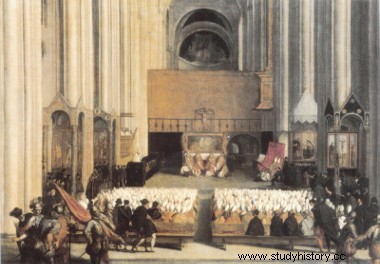
By Me. Cláudio Fernandes
The Council of Trent , carried out between the 1540s and 1560s, in the homonymous Italian city, had a great impact in the context of the Counter-Reformation operated by the Catholic Church.
It is known that the Protestant Reformations had an impact on 16th century Europe that went far beyond the religious aspect. Reformists, especially Luther , who had great oratory skills and also a great penetration among the lay public, offered the various principalities that made up the Holy Roman Empire the possibility of articulating themselves politically without the express consent of the Emperor and the Church.
Reformists criticized the behavior of Church representatives who occupied high positions within the ecclesiastical hierarchy, who had great political influence and little spiritual care. Despite the theological proposals (for many, considered revolutionary and heretical), the Protestant Reformations ended up opening up the religious civil wars in Europe, a fact that gave rise to the modern National State, under absolutist features.
The Catholic Church, in this context, pondered the criticisms of the reformers and sought to resolve the problem institutionally and spiritually. The Council Ecumenical from Trent was in this second category, as it was brought together with the purpose of reaffirming Catholic dogmas and readjusting the conduct of Catholic clergy and laity within these doctrines.
The realization of the council began in 1545 from a papal bull published in 1542. Some historians, such as the British Christopher Dawson, defend the argument that the council cannot be considered with a response to the Lutheran Reformation, given that the response to the German reform was already being given institutionally and militarily through the continent's internal wars. The Council of Trent stipulated spiritual guidelines according to what the tradition of the Doctors of the Church and of the saints had always defended.
Due to incessant wars, the council had a first interruption in 1547. Its continuation took place between the years 1551 and 1552, when it had to be interrupted again. The third and last meeting took place between the years 1562 and 1563, under the pontificate of Pius IV .
Christopher Dawson listed, in his work The Division of Christianity – From the Protestant Reformation to the Age of Enlightenment , the most important points of the Council of Trent:
Its importance to the Church, however, cannot be overestimated. It offered conditions for the Church to recover the forces of orthodoxy that were dispersed and disorganized and provided a solid foundation of dogma and discipline, from which new advances could be made. Above all, it brought the full weight of authority to suppress easily noticed abuses that caused the breakdown of ecclesiastical government – the absence of bishops and pastors from the places where they should exercise their functions, pluralism or accumulation of benefits, neglect of prayer, neglect of clerical education and many others. [1]
In addition, two other resolutions deserve to be mentioned:1) the publication of the Index Librorum Prohibitorum , that is, the Index of Books Prohibited by the Church, in which were, among other titles, “Decameron”, by Boccaccio , and “The Praise of Madness”, by Erasmus from Rotterdam. 2) the preservation of the Mass rite and its value as a celebration of Christ's sacrifice. This value can be seen in Chapter III, Section XXII, of the Council of Trent, held on September 17, 1562, which follows below:
Although the Church has had the custom of celebrating, on several occasions, some masses in honor and memory of the saints, it teaches that sacrifice is offered to these, but only to God, who gave them the crown, whence the priest never says:"I offer you, O Saint Peter" or "O Saint Paul, this sacrifice...", but giving thank God for the victories they have achieved, he implores his help so that the same saints whom we remember on earth, deign to intercede for us in heaven.
NOTES
[1] DAWSON, Christopher. The Division of Christianity . São Paulo:É Realizações, 2014. p. 191.
